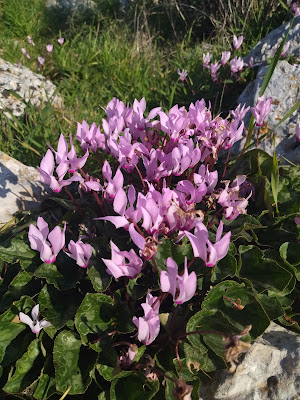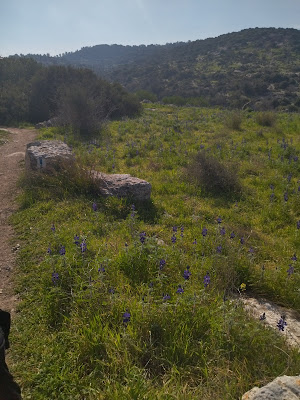Givat HaTurmosim or Lupine Hill is what everyone calls it. But
that’s not its proper, biblical name. That would be Tel Socho in the Elah
Valley, where David fought Goliath:
The Philistines assembled their forces for battle; they massed at Socho of Judah, and encamped at Ephes-dammim, between Socho and Azekah.
Saul and the men of Israel massed and encamped in the valley of Elah. They drew up their line of battle against the Philistines, with the Philistines stationed on one hill and Israel stationed on the opposite hill; the ravine was between them.
A champion of the Philistine forces stepped forward; his name was Goliath of Gath, and he was six cubits and a span tall. (1 Samuel 17:1-4)
The history is reason enough to make a pilgrimage to this
scenic spot, located in the Beit Shemesh area. But there’s another reason to
visit, and that’s the lupines, which bloom here in profusion from approximately
late February to early March. The lupine, Lupinus pilosus,
derives its name from the Latin lupus, or "wolf,” an allusion to the
ancient (false) belief that the plant destroys the soil in which it grows,
rendering the earth henceforth infertile. The second part of the botanical name of this
flower, “pilosus,” refers to the velvety plant’s covering of long, soft hairs.
 |
| Lupinus pilosus, the blue lupine |
The purplish-blue flowers are picky. They grow on this hill,
and just a few feet away, they won’t, except for a few rogue lupines here and
there, a tantalizing clue to the view that awaits one up ahead. Even at the top,
prime lupine location, the flowers decide where they will and won't live.
In some places the lupines grow on one side of the well-trampled path, but not
on the other. Lupines like nitrogen-rich soil, and will scorn the earth a stone’s
throw away should it lack this essential nutrient.
Somewhat mirroring this phenomenon, I live 35 minutes away from Givat
HaTurmosim, but never managed a visit until last Friday. That’s when my husband
and I finally made it over there, arriving while the morning dew still glistened on the
flowers. The leaves and wild grasses were slippery, wet, and treacherous. We
didn’t know what we were doing and took the most difficult path we might have
chosen, believing it to be the only one that would take us to the top and the
storied blue flowers.
In the end, we were lucky (or you wouldn't be reading this). We made it to the top and when we
did, we discovered we were not the only ones to take a hike that morning. There
were young lovers picnicking; Russian immigrants snapping photos, and a group
of helmeted bike riders from Tel Aviv. The latter, once consulted, were kind
enough to tell us of an easier path for our return.
Yay. Now I could stop worrying and just enjoy.
 |
| The waving of the Terrible Towel at Givat HaTurmosim. |
First there were only a few lupines, scattered here and there. Soon, they were everywhere we looked, interspersed with other wildflowers: patches of wild cyclamen in various shades of pink; lots of red poppies; and the pollen-rich yellow mustard flowers--just looking at them makes one sneeze. No matter. It was lovely and it was a lovely day. We heard birdsong and foxes calling to each other from their dens. Some hikers had brought their dogs along, and the dogs were happy to be running free. The vibe, in general, was happy, peaceful.
 |
| This time of year, the kalaniot are everywhere. The red poppies are protected flowers. |
 |
| Cyclamen (rakefet) |
It was like the Swiss Alps up there, and I kept expecting to see Heidi, her grandfather, and Peter the goatherd—or at the very least Maria Von Trapp.
But no. We were not in Switzerland or Austria, but on a small hilltop with a delightful microclimate that a loving God designed with the lupine in mind.
|
Or order from your favorite bookseller, using ISBN 9798985708424. Read all about it here! |

|

.jpg)





